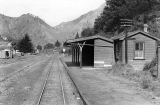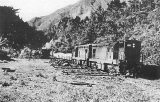Ohinemuri Regional History Journal 47, September 2003
By J A T Terry
Karangahake Station, until Mackaytown opened in October 1906, was the first station from Paeroa on the Paeroa-Waihi line. Railway Working Timetables showed it as being 4 miles 40 chains from the first Paeroa Station and 5 miles 14 chains from the second station. While the line to Waihi was taken over by the Working Railways on 9 November 1905, trains had been running to Karangahake long before that.
It was at Karangahake that the first sod of the railway was turned. On Friday 2 March 1900, at a site on the south side of the Ohinemuri River, just below the Crown Battery, alongside the residence of Mr Hutchinson, the Battery Superintendent, a temporary platform had been erected. Here the Minister for Railways, the Hon. J G Ward, turned the first sod (NZ Herald 3 March 1900).
In the early stages, one matter which was reported as retarding operations was the diversity of opinion at Karangahake as to the best site for the station. Some favoured a site in the centre of the township, while others approved that near the Crown Battery, chosen by the Government Engineer (NZ Herald 7 July 1900). On 22 September 1900 the Ohinemuri Gazette reported that the station would be close to the site of Mr Hutchinson's new house, which may have to be moved.
By June 1902, rails had been laid into Karangahake, but the track not ballasted. The Ohinemuri Gazette (1 May 1903) reported that the yard was just about finished. The big move by the public was to get the line opened to goods traffic from Paeroa to Karangahake. The Government had agreed that everything would be ready for the commencement of (goods) traffic on 1 October. The erection of a goods shed would get priority (NZ Herald 29 August 1903). The Ohinemuri County Council was informed that, in addition, the line to Karangahake would be opened for all classes in December (Ohinemuri Gazette 2 October 1903).
The first of October came and went without the line being opened for goods traffic. Different reasons were given - limited number of men employed (NZ Herald 7 October 1903) and it was not the usual course of the Government to open one portion where short sections of lines were concerned (Waikato Times 9 December 1903). However, before Christmas, the Public Works Department started running goods trains to Karangahake. Having got their wish, the public were not satisfied. Petitions were started in the town for the line to be taken over and controlled by the Railway Department. The big concern was the high tariff set by the Public Works Department (NZ Herald 20 January 1904). However, no matter what the public thought, the line to Karangahake would have been a great relief to the Gold Mining Company, for it was reported that nearly all the Waihi coal supply was now conveyed by rail to Karangahake, where a large hopper had been erected. Clarkson's wagons could now make two trips a day from Karangahake instead of one, as formerly from Paeroa (New Zealand Herald 23 January 1904). The Hamilton-based Waikato Argus (16 February 1904) was scathing of the station facilities. 'The goods shed and station office at Karangahake just completed has been built without regard for the requirements of the town or the convenience of the public. The station house just completed consists of an office and waiting room, has a total length of 21ft 9 ½ inches which is the usual size of a private person's washhouse. The goods shed is 30ft x 12 feet and these buildings are supposed to satisfy the requirements of a township with a population of about 2000'.
The first passenger train was soon on the scene. The Ohinemuri Gazette of 9 March 1904 reported Fitzgerald's Circus would arrive in Karangahake by special train on the evening of Friday 11 March, remarking that it would be the first occasion on which a passenger train would connect Paeroa with Karangahake.
A request from the Thames Borough Council that the section to Karangahake be handed over to the Railway Department for all traffic was rejected by the Minister for Public Works. The reason given was the opening of the line for ordinary traffic would materially interfere with the carrying on of the works beyond Karangahake and would delay the much desired completion of the line to Waihi (Waikato Times 24 March 1904).
By May 1904 the whole of the coal used by the Waihi Gold Mining Company was conveyed by rail as far as the double decked bridge. From there it was loaded into heavy wagons standing below on the roadway of the bridge and then carted to Waikino (New Zealand Herald 31 May 1904). Presumably the hopper at the station had been dispensed with for a photo shows a hopper attached to the underside of the rail section, for the discharge of coal into the wagons.(See photo 1)
The station would have been a busy place. The Ohinemuri Gazette (2 November 1904) reported that over 200 tons of coal were conveyed on the Paeroa-Karangahake trains every day for use at Waihi, Talisman and Crown Mines. This was in addition to other mining requirements such as bricks, slabs, etc., bringing the daily tonnage to over 400 tons.
On 9 November 1905 the line to Waihi was taken over from the Public Works Department and opened for all traffic. (See photo 2) At Karangahake there was a 6th class station building, platform, urinal, goods shed 30ft x 12ft, loading bank and two loop lines holding 33 and 32 wagons respectively. There was a locomotive water supply 55 chains south of the station. This consisted of two 400 gallon iron tanks, water being obtained from the Ohinemuri County Council supply. Station lamps were gas lit. A stationmaster, the only staff member, was in charge. That position was temporarily filled by Mr McCurdy until the permanent appointee, Mr Delaney, took up office. He remained there until March 1913 when he was transferred to Ngaruawahia as Stationmaster.
There was a house for the stationmaster on the eastern side of the yard and one for the platelayer on the eastern side of the hillside, just over the combined bridge.
Sometime between April and August 1907, the tablet system was installed between Paeroa and Waihi and Karangahake was made a tablet station. Probably during that time, home signals were erected. The station building was moved back, the office accommodation greatly enlarged, a ladies waiting room added and a verandah erected. The total cost of these improvements was £264.
To cope with increased traffic, in June 1907 approval was given to appoint a porter to assist the Stationmaster. In October 1907 Mr J H H Thomas was appointed. The station was open twelve hours each day. After 1913, details showing the number of staff employed and the number of hours that the station was open, no longer appeared in Railway Statements. The 1913 Statement did show that in that year, the station hours had been increased to thirteen.
By September 1917, business at the station had declined and it was decided to withdraw the stationmaster, who was on a yearly salary of £220. This was effective after the close of business on Saturday 13 October 1917.
Station revenue earned for the first full financial year (1 April 1906 to 31 March 1907) was £1,711. The best year was 1912, with £5,258, dropping to £4,033 in 1917. 15,803 tickets were sold in the 1907 year, the highest being 21,474 in 1913 with 14,386 in 1917. Timber railed from the station in 1907 was 12,400 super feet, the best year, 1912, with 8,454,600 super feet, with 55,400 super feet in 1917.
In 1930, with need for economy, the position of the tablet porter at both Karangahake and Waikino was reviewed. Should both have been removed, there would have been an annual saving of £504.9.10. In the end it was decided that while there was more business at Waikino, Karangahake gave a better division of the area and it had the additional advantage of being reasonably adjacent to the sub-terminal station of Paeroa. So Karangahake survived but it was changed in status from a full tablet station to a switch out station. This reduced the hours of the tablet porter. It took effect from 3 February 1931.
This was not the first time that the closing of these stations had been considered. In 1926 the suggestion was made, but not recommended on account of the approaching completion of the Waihi-Tauranga section. To make further economies, train schedules were rearranged and the station made a holiday switch from 4 April 1932. This meant it would be open only when required for train running services. The tablet porter was withdrawn and a porter would be sent from Paeroa when it was necessary to operate the tablet machines. The tablet porter, Mr T Cotter was transferred to Ruakura. The station was now classed as an unattended flag holiday switch. The local surfaceman looked after the station as well as his ordinary duties. He received no extra remuneration for these additional duties but in 1938 the situation was reviewed and as a result, from May 1938, he was paid an additional 7/6 per week.
From 1950, it was all down hill for the station. In June of that year, a private contractor removed the goods shed to the Lichfield Station. This move cost £191. In November 1950 a portion at the Waihi end of the station building was relocated for use as a carpenters' shop at the Frankton Car and Wagon depot. Early in the 1950s, the locomotive watering facilities were removed and in December 1957 the gents' conveniences. As from Monday 20 April 1959, Karangahake was closed as a holiday switch station and was now only an unattended flag station. The tablet machines and home signals were removed and the main line to loop points spiked.
Tenders for what was left of the station building closed on 24 August 1960. On 25 September 1961, the station was brought back into use as a tablet locked siding. This involved the lifting of the crossing loop and shortening the siding which now held 17 wagons on a back shunt. It could be shunted from the Waihi end only. Tablet locks were placed on the points.
From and including Monday 22 June 1964, the station was closed to all traffic and reclassified as a service siding to be used for railway maintenance purposes only. It remained in that capacity until August 1972 when the service siding was removed. Karangahake station was no more.
During the years it had been open for passenger traffic, the local population had been well served in respect of accommodation on trains for passengers. This ten-yearly period table shows the trains which ran daily, Sundays excepted. Goods trains with carriage attached could be cancelled on public holidays:
1907 - 4 mixed trains
1917 - 2 mixed trains
1927 -4 mixed trains
All of the above were time tabled to stop at Karangahake.
1937 to 1947 - One passenger train, the Taneatua Express, on the days on which it ran.
1 Mixed train and 1 goods train, with carriage attached. All of these trains were not time tabled to stop, but would do so on request.
1957 - 2 goods trains, with passenger car attached (stop on request).
The Taneatua Express, on days it ran (stop on request).
Since the withdrawal of the porter in April 1932, passengers boarding trains at Karangahake were required to obtain tickets from the guard.
References:
District Engineer NZR Hamilton file 169/2 Sidings Karangahake
District Engineer NZR Hamilton file 169/7 Goods Shed Karangahake
Signal & Electrical Inspector NZR Hamilton. File 119/1 Karangahake
General Manager NZR Wellington. File 07/2513. Staff Karangahake (NZR & Locomotive Society Ava Museum.)
AJHR D 2. Railways Statement 1906-1917, Statement of Revenue and Expenditure.









